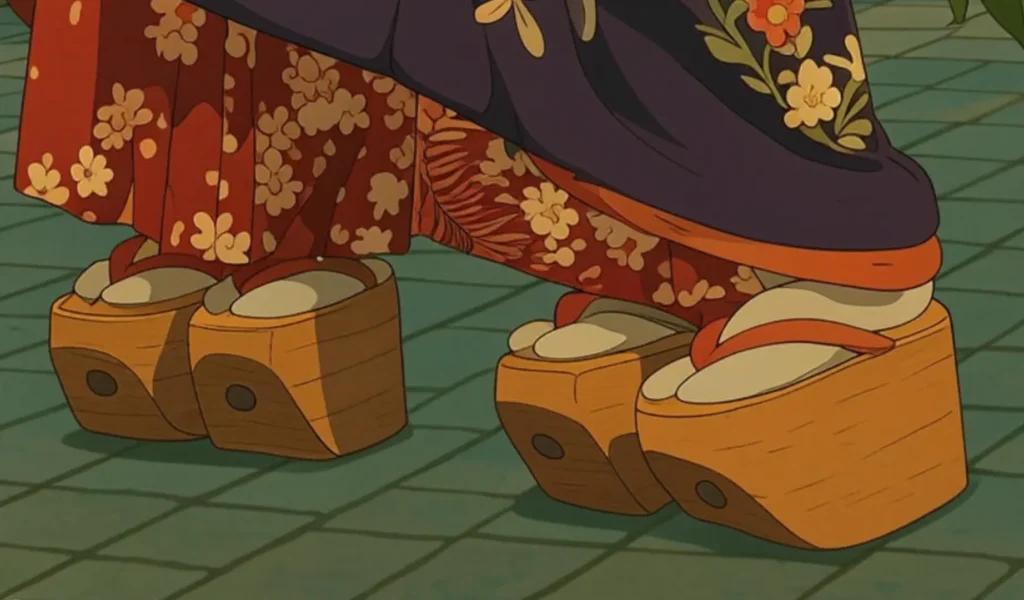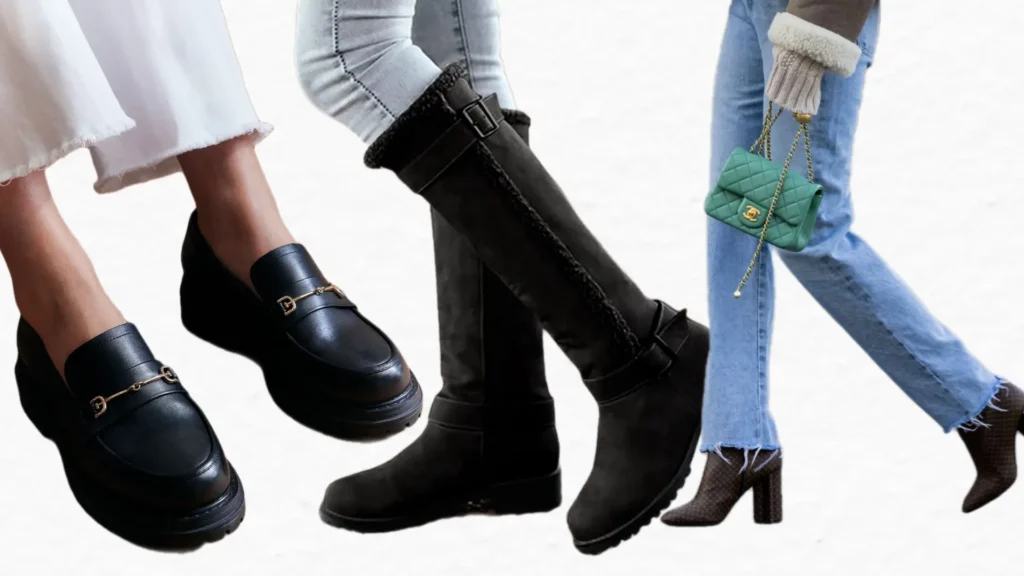Geta sandals have journeyed from practical necessities of ancient Japan to captivating elements of modern fashion. These elevated wooden sandals, distinguished by their simple thong straps, once shielded feet from mud and rain in a pre-modern landscape.
Today, they enchant designers, fashion enthusiasts, and cultural aficionados, merging centuries-old heritage with contemporary flair.
Historical Background of Geta Sandals
Geta sandals emerged during Japan’s Heian period (794–1185), a time when elevated footwear addressed practical needs. Japan’s muddy streets, rainy seasons, and wet rice paddies demanded a solution to keep feet and clothing clean.
The term “geta” combines “ge” (lower) and “ta” (board), reflecting their core design: a wooden platform raised by two or three prongs, or “ha,” paired with a fabric or leather thong called “hanao.” Initially, geta served farmers, merchants, and travelers, lifting kimono hems above the ground and offering stability in uneven terrain.
Geta designs evolved to suit diverse needs and social roles:
- Taka-geta: High-platform sandals, often 10–20 cm tall, worn by courtesans, actors, and the elite to signify status and elegance, their height amplifying presence.
- Zori-influenced Geta: Lower, flatter variants for formal occasions, blending elements of zori sandals, often worn with ceremonial kimono.
- Okobo: Tall, single-block geta, favored by maiko (apprentice geisha), typically lacquered in striking red or black for visual impact.
- Ashida Geta: High-pronged designs for rainy weather, elevating wearers further from wet ground. Crafted from lightweight paulownia wood—prized for durability and low weight—geta featured hanao of cotton, silk, or leather, tailored for comfort and style. Ornamentation varied: plain wood for commoners, carved or lacquered finishes for the wealthy.
Geta transcended utility, embedding themselves in Japan’s cultural identity. Their signature “karan-koron” clacking sound, produced by wood striking ground, announced a wearer’s approach, a social signal in the Edo period (1603–1868).
They harmonized with kimono, yukata, and other garments, embodying wabi-sabi—Japan’s aesthetic of beauty in simplicity and imperfection. Geta starred in kabuki theater, tea ceremonies, and Obon, tying them to art, ritual, and community. They also symbolized resilience, their elevation reflecting a practical yet poetic response to life’s challenges.
Geta were unisex, worn by men, women, and children, but designs hinted at social cues. Men’s geta featured wider, sturdier bases for labor or travel, while women’s, especially for geisha or courtesans, were taller and more delicate, enhancing grace.
Children’s geta, smaller and simpler, prepared young feet for traditional life. This versatility cemented geta’s role across society.
Craftsmanship of Geta Sandals
Traditional geta craftsmanship is a meticulous art:
Wood: Paulownia, cedar, or cypress—light, strong, and resistant to rot—forms the base, hand-sanded for smoothness and often lacquered for durability or shine.
Hanao: The thong, crafted from cotton, silk, or leather, threads through holes in the wood, hand-stitched and adjustable for a snug fit.
Ha: Typically two prongs, occasionally three, are precisely cut and joined to balance weight and stability, ensuring safe elevation. Artisans, trained over decades, shape each pair by hand, a skill passed through generations in family workshops. The process blends function and beauty, with each piece unique.
Japan’s regions birthed distinct geta styles:
Fukuyama Geta: From Hiroshima Prefecture, these sturdy, practical sandals suited laborers and rural life.
Hida Geta: Crafted in Gifu, known for intricate carvings or inlays, reflecting the area’s woodworking legacy.
Tengu Geta: Single-prong, high-balance sandals, linked to mythical tengu creatures and worn by ascetic monks for spiritual discipline.
Nagaoka Geta: From Niigata, these featured robust designs for snowy or wet climates. Regional variations showcase Japan’s diversity, adapting geta to local needs, aesthetics, and resources.
Crafting geta demands precision. Artisans select wood, cut the base, and carve prongs with chisels, ensuring alignment for balance. Hanao weaving involves dyeing fabrics, stitching, and threading, often customized to the wearer’s foot.
Lacquering, using urushi (natural lacquer), adds durability and a glossy finish, a technique honed over centuries. This labor-intensive process underscores geta’s value as both utility and art.
Decline in Traditional Use
By the 20th century, Western shoes—versatile, mass-produced, and suited to urban life—overtook geta. Post-World War II modernization brought sneakers, boots, and leather footwear to Japan, relegating geta to niche roles: festivals, tea ceremonies, and geisha culture.
Department stores and global trade favored imports, diminishing daily use. Yet, this shift sparked curiosity, paving the way for geta’s modern revival.
Geta in Modern Fashion: A Revival
Since the 2000s, geta have resurged in Japan’s fashion scene, a blend of tradition and avant-garde. Designers like Issey Miyake, Comme des Garçons, and Yohji Yamamoto reimagined geta, pairing them with minimalist dresses, layered kimono-inspired looks, or edgy jackets. Summer festivals like Obon and Gion Matsuri saw yukata-clad youth donning geta, their clacking sound echoing tradition. This revival fueled boutique production and consumer interest, blending nostalgia with fresh appeal.
Geta’s sculptural form—elevated, bold, and unique—captivated international designers. In the 2010s, Paris, Milan, and New York runways showcased geta-inspired footwear:
Alexander McQueen and Dior featured elevated wooden soles with sleek leather or metallic straps, nodding to geta’s silhouette.
Balenciaga and Rick Owens experimented with chunky, high platforms, blending Eastern and Western aesthetics.
Geta sandals paired with flowing gowns, tailored suits, or deconstructed looks, celebrating cross-cultural design. Fashion magazines Vogue and Harper’s Bazaar praised geta’s bold geometry, introducing them to global audiences as statement pieces.
Streetwear, a powerhouse in modern fashion, embraced geta for their daring look. In Tokyo’s Harajuku and Shibuya districts, youth mix geta with denim, graphic tees, hoodies, and techwear, creating a fusion style. Pop culture amplified this:
Demon Slayer and Naruto feature characters in stylized geta, inspiring cosplay and replica designs.
J-Pop idols, K-Pop stars, and Western artists have worn geta-inspired footwear.
Lolita fashion, cyberpunk, and steampunk have adopted geta, customizing them with lace, studs, or neon finishes. Cosplayers craft geta for authenticity, while street photographers capture their quirky charm, cementing geta’s place in niche and mainstream style.
Modern Adaptations and Innovations
Contemporary geta evolve for modern needs:
Materials: Rubber, foam, or recycled plastics form soles, adding cushioning and durability.
Hanao Variations: Vegan leather, nylon, or padded fabrics replace traditional materials, enhancing comfort and ethics.
Height and Shape: Lower, ergonomic prongs or flat soles suit daily wear, while exaggerated, sculptural designs target bold fashion.
Color and Finish: Bright hues, metallic lacquers, or matte textures modernize the look. Japanese brands like Suicoke, Hender Scheme, and Visvim lead, offering sleek, functional geta hybrids for urban life.
Geta sandals align seamlessly with fashion’s sustainability push, offering an eco-conscious alternative in a wasteful industry. Craftsmen utilize eco-friendly reclaimed wood, bamboo, and biodegradable composites, significantly reducing environmental impact while maintaining the sandals’ traditional charm.
By embracing these sustainable resources, geta minimize reliance on resource-heavy production, appealing to environmentally aware consumers seeking greener fashion choices.
In contrast to fast fashion’s disposable nature, handmade geta embody slow fashion principles, with durable designs crafted to last years with proper care. Supporting local artisans in Gifu and Hiroshima not only preserves time-honored skills but also boosts small economies, fostering community resilience.
Innovation thrives through partnerships that reimagine traditional Japanese geta sandals for modern contexts. High-profile designer collaborations, such as Comme des Garçons’ 2020 line with Gifu artisans, fuse tradition with couture, blending the meticulous craftsmanship of regional workshops with avant-garde fashion sensibilities.
Similarly, streetwear A Bathing Ape and Supreme reinvent geta by incorporating bold logos, vibrant patterns, and urban flair, appealing to younger, trend-driven audiences and injecting contemporary energy into this ancient footwear.
Customization further enhances geta’s versatility, allowing wearers to blend heritage with personal style. Etsy and Japanese boutiques empower consumers to personalize hanao colors, wood finishes, and even engravings, tailoring each pair to individual tastes.
These collaborative and bespoke efforts bridge the gap between Japan’s cultural legacy and modern fashion, ensuring geta remain relevant, dynamic, and uniquely expressive in today’s diverse style landscape.
Cultural Implications and Challenges
The revival of geta sandals ignites a lively debate about tradition and modernity. Purists express concern that mass-produced or Westernized versions—featuring plastic soles and flashy designs—dilute the authenticity of this Japanese craft, risking the loss of its cultural essence.
Conversely, others argue adaptation is vital for relevance, allowing geta to thrive in contemporary fashion by appealing to diverse, global audiences and keeping the style alive.
Preservation efforts strive to protect geta’s heritage while embracing innovation. Artisans in Kyoto and Gifu lead workshops, teaching geta-making to youth and passing down centuries-old skills.
Museums and exhibits, such as Tokyo’s Edo-Tokyo Museum and Kyoto’s craft centers, display historical geta, educating visitors about their significance. Documentation through books and films chronicles traditional methods, safeguarding knowledge for future generations. Balancing heritage with innovation remains key to ensuring geta’s legacy endures.
Modern adoption of geta faces distinct hurdles. Rigid wood and elevated designs strain feet, making daily wear challenging. Designers counter with cushioned soles and adjustable straps to boost comfort and usability.
Cultural perception poses another issue. Outside Japan, geta risk being seen as exotic or costume-like, sparking appropriation debates. Cultural guides from designers aim to foster respect and understanding.
Safety is a concern too. High prongs demand balance, tricky in fast-paced settings. Thoughtful design tweaks help align geta with modern lifestyles.
Geta’s global rise depends on fit and cost. Western feet, often larger, prompt brands to offer wider bases and flexible hanao. This adjustment broadens their appeal.
Education bridges gaps. Blogs, videos, and styling tips clarify cultural and practical aspects. This makes geta more accessible worldwide.
Global adoption stirs sensitivity concerns. Wearing geta flippantly or without context can offend. Misuse challenges respectful integration.
Fashion houses and influencers respond proactively. Campaigns explain geta’s history and significance. These efforts encourage thoughtful, respectful wear and dialogue.
Geta in Everyday Modern Fashion
Geta adapt well to daily style. Paired with yukata, sundresses, or shorts at festivals, they add tradition. They blend ease and flair for summer.
Casual outfits gain an eclectic vibe. Geta complement jeans, skirts, or oversized tees effectively. This versatility suits varied tastes.
YouTube tutorials and blogs like Japan Trend Shop help. They teach styling for everyday use. Geta become approachable for all.
Geta shine in bold settings. Runway drama features exaggerated heights and metallic finishes. Carved designs make striking statements.
Art installations embrace geta too. They symbolize cultural fusion or impermanence in galleries. This elevates their artistic role.
Editorial shoots highlight their allure. Magazines pair geta with couture for impact. Their versatility fuels creativity across mediums.
Geta are historically unisex. Neutral designs in black or wood tones appeal broadly. They suit all wearers.
Bold options stand out. Vibrant patterns, glitter, or studs embrace self-expression. This aligns with fashion’s inclusive turn.
Designers cater to all genders. They offer varied styles for everyone. Geta reflect modern inclusivity well.
Geta enter digital realms boldly. Games like Animal Crossing and VR platforms feature geta for avatars. This expands their presence.
NFT fashion innovates further. Artists create digital geta as non-fungible tokens. Tradition meets cutting-edge tech here.
Social media boosts visibility. Instagram and Snapchat filters let users “wear” geta. This trend reaches tech-savvy audiences.
Japanese pioneers redefine geta. Issey Miyake’s 2015 collection paired low, modernized geta with geometric dresses. It blends East and West.
Hender Scheme excels too. Leather-crafted geta fuse artisanal roots with urban style. These efforts show high fashion potential.
Global fashion embraces geta. Dior’s 2019 Cruise featured geta-inspired platform sandals with silk gowns. Critics raved at the fusion.
Streetwear thrives in L.A. U.S. influencers mix geta with hoodies and chains. These examples highlight global versatility.
Small workshops lead a revival. Gifu’s Hida Takumi sells custom geta online. Handcraft meets e-commerce seamlessly.
Their success is telling. Demand for authentic, artisanal geta grows. Tradition endures through modern channels.
Traditional Japanese geta sandals, from humble origins in muddy fields, have strode boldly into modern fashion. Their history—rooted in utility, craftsmanship, and culture—fuels a revival across Japan and beyond. Geta sandals prove heritage can step confidently into the future, resonating “karan-koron” across time and borders.




